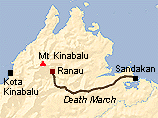|
Sandakan Death
Marches
|
|
Barbarian Japanese Kill 4,000 Indonesian, 1,381
Australians and 641 British prisoners
|
|
| The Sandakan Death Marches resulted
in the deaths of more than 6,000 Indonesian civilian slave laborers and
Allied prisoners of war, held by the Empire of Japan during the Pacific
campaign of World War II, at prison camps in North Borneo. Of all the prisoners
held at Sandakan, forced onto the Death Marches and at Ranau, only 6 who
escaped survived the war. |
| In 1942, Indonesian civilians, from
Java, along with Australian and British POWs, who had been captured at
the fall of Singapore, were shipped to North Borneo, to build a military
airstrip at Sandakan. As on the Burma Railway, the prisoners were worked
hard at gunpoint, were often beaten and received little food or medical
treatment. Most had died as a result of their treatment by early 1945.
When Allied landings in the area appeared increasingly likely, the camp
commandant, Captain Susumi Hoshijima decided to move the remaining prisoners
inland to Ranau, a distance of 250 kilometers. |
|
|

|
| A first phase of marches, through
swamps, jungle and mountainous areas occurred between January and March,
1945. In several groups, 455 POWs, all of whom were malnourished and/or
suffering serious illness, started the journey. Although the route took
nine days, they were given and made to carry four days' rations. POWs who
were not fit enough to complete the journey were either killed or left
to die enroute. The worst was yet to come for the roughly 140 men who completed
the journey were herded into unsanitary and crowded huts and many died
from dysentery. By 26 June, only five Australians and one British soldier
were still alive." |
|
|
|
| Meanwhile, at the Sandakan camp,
some 885 POWs died of hunger and illness between February and May. A second
wave of forced marches to Ranau began on May 29, when the camp was closed
and destroyed by the Japanese. A group of 536 POWs were sent towards Ranau
almost 300 prisoners who were not well enough to move were either killed,
or left to die in the ruins of the Sandakan camp. |
|

|
| October 24, 1945. Sandakan POW camp,
a few months after it was vacated and demolished by retreating Japanese
troops. In an area above graves containing the bodies of 300 Australian
and British prisoners were discovered. |
|
|
| The marchers were even less fit than
those in the first phase, were provided with fewer rations and were forced
to forage for food along the way. Only 183 POWs remained when the group
reached Ranau on 27 June. By the end of July, when four prisoners escaped,
the last to do so, there were only 40 POWs still alive at Ranau and none
of these 40 survived the war. They were killed by the guards in August,
possibly up to 12 days after the war ended on August 14. |
|

|
| October 26, 1945 Sergeant Hosotani
Naoji (left, seated) confessed to shooting two Australian POWs and five
ethnic Chinese civilians. |
| Of the six Allied survivors, all
of whom were Australian soldiers, only three survived the lingering effects
of their ordeal to give evidence at war crimes trials in Tokyo and Rabaul.
Hokijima was found guilty and hanged on April 6, 1946. |
|
Info Wikipedia - Photo's F.
Burk
|
|
|